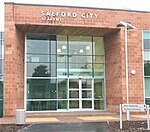Davyhulme Sewage Works

Davyhulme Sewage Works is the main waste water treatment works for the city of Manchester, England, and one of the largest in Europe. It was opened in 1894, and has pioneered the improvement of treatment processes. With the growth of population in the late nineteenth century, and the proliferation of water closets, the rivers around Manchester were becoming grossly polluted, and the City of Manchester decided to build two deep level sewers to intercept existing sewers. When the first one reached Davyhulme, further extension was blocked by the Manchester Ship Canal, and so a treatment works was built there. The works used precipitation tanks, and a 3 ft (914 mm) gauge tramway was built, to facilitate the movement of materials around the site. The first steam locomotive was acquired in 1897, and a further fourteen steam and two diesel locomotives operated on the system before its closure in 1958. Treated sludge was loaded into ships and discharged into the Mersey estuary from 1898. Over the next hundred years, seven ships were used to transport the sludge, including one borrowed from Glasgow after another hit a mine and sank. At first, ships used the ship canal to transport sludge from the works, but later a pipeline was built to Liverpool, and the ships made a much shorter journey. An early feature was a laboratory, where trials of various types of filter were carried out, and incoming effluent was analysed. Attempts to improve the treatment process proved successful in 1914, when two chemists, Ardern and Lockett, discovered the Activated Sludge Process, which was soon in use worldwide. A second deep level sewer, started in 1911, eventually reached the works in 1928, and to cope with the increased flows, half of the sewage was fed into a new Activated Sludge plant. Three separate operating systems were installed, so that comparisons on their efficiency could be made. A second Activated Sludge plant was built between 1955 and 1966, and the control system on the first was upgraded between 1970 and 1973. In 1974, the Rivers Committee, which had managed the site since its inception, ceased to be, when water and sewage treatment became the responsibility of the newly formed North West Water Authority. The organisation was subsequently privatised, and became part of United Utilities in 1995. In order to meet demands for better water quality, a pilot Biostyr plant was built in 1992, and a much larger one was completed in 1998. Innovation continued, with the commissioning of the world's largest thermal hydrolysis plant in 2013, using a new process to break down sludge, which generates methane as a by-product, enabling the site to be self-sufficient for gas and electricity. An upgrade to the Activated Sludge plant began in 2014, and is expected to be completed in 2018.
Excerpt from the Wikipedia article Davyhulme Sewage Works (License: CC BY-SA 3.0, Authors, Images).Davyhulme Sewage Works
Barton High Level Bridge, Trafford Peel Green
Geographical coordinates (GPS) Address External links Nearby Places Show on map
Geographical coordinates (GPS)
| Latitude | Longitude |
|---|---|
| N 53.4635 ° | E -2.3723 ° |
Address
Davyhulme Wastewater Treatment Works
Barton High Level Bridge
M17 8DD Trafford, Peel Green
England, United Kingdom
Open on Google Maps






